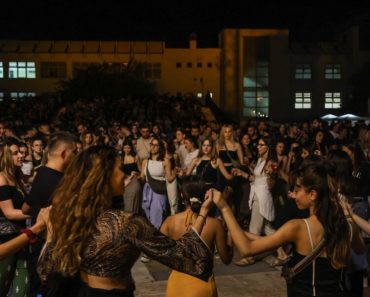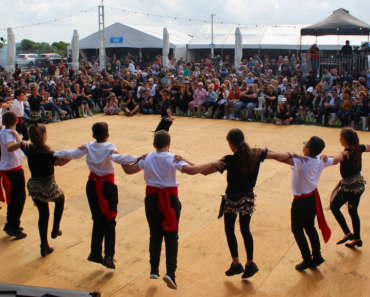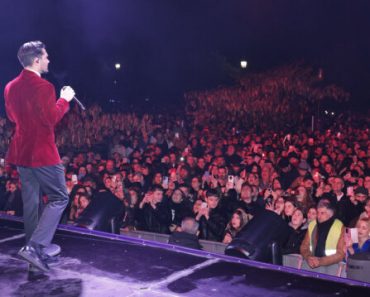ATHENS – All gifted film makers are able to place viewers into the worlds they create, but it is a rare movie that leaves the audience wishing they could actually go there. Such is the experience with Maria Iliou’s latest work, the remarkable documentary, ‘Athens of the Interwar Period, 1922-1940’.
It’s the third installment of Iliou’s already monumental series titled ‘Athens Rising’ that documents the evolution of modern Athens. It reveals to people who live and visit our Athens how it got here, showing it sprouting beneath, around, and between the ancient monuments, the tumultuous place where parents and grandparents and historical figures were born and lived, struggled, thrived, and died.

Faces and scenes, with the piano music throughout providing emotional depth accompanying images of joy, struggle, and change portray a crucial historical period. They reach out and touch the viewer through the evocative music composed by Katerina Polemi and the images imaginatively presented through the superb editing of Aliki Panagi.
The film premiered January 17 in Athens and was introduced by Iliou, who was warmly received by the audience that packed the theater.
“The interwar years were an interesting period, creative and filled with contrasts,” she said, “and once again colleagues in Europe and America discovered unknown films” showing Athenians in their city, living and experiencing, demonstrating and protesting, as in 1924 in favor of a republic, and1936 against the government’s inability to cushion the blows of the Great Depression, which arrived late in Greece.
Still and moving pictures displayed the physical, and emotional dislocations and suffering – but also the adjustments and beginning of recovery – of the refugees from Asia Minor, as well as the expression of the complaints and demands of the working class, including the rise of labor confederations and the Greek Communist party.
First onscreen were the refugees, who virtually doubled the city’s population in a few years – they literally marched up Piraeus Avenue from the port into Athens Centre, at first occupying tents and venues like theaters, and later building humble structures they turned into real homes, significantly not allowing the places where they lived to becomes slums – rather they are now among Athens’ key neighborhoods, with names evoking lost lands: Nea Smyrni, Nea Philadelphia, Nea Iraklio, etc. They not only enlarged the city, they enriched it – their initial poverty notwithstanding – with their commercial skills and cultural wealth – cuisine, music, the arts. And their education – there were many artists, intellectuals, and musicians, changing the way Athenians think, write, and make music on commentator noted.

The film shows the construction of crucial infrastructure, from the first airport to the electrification of much of the rail line to the massive and vital marathon dam that finally brought healthy water to everyone. Also well-depicted are cultural developments, the beginning of the spectacular excavations of the American School of Classical Studies at Athens (ASCSA) not least among them.
Education reforms and endeavors, a priority of Venizelos, was represented by the renowned Athens College, a prep school which established a Hellenic foundation for the education many students eventually received at Europe’s top schools.
Equally fascinating were photos from the introduction of modern housing, including kitchens with electrical appliances, but one of the film’s main contributions is the presentation of two radically conflicting worlds side by side in Athens – the modernizing but struggling working classes, and the rising bourgeoisie, especially the wealthy families from the Diaspora who accelerated Greece’s industrialization – the rise of Greek shipping was highlighted – creating jobs, yes, but with wages that could not drive away hunger and working conditions that prompted continuous demonstrations and fed the ranks of the Communist party.
Time was devoted to the predominant political reality – the ‘dihasmos’ – the national division between supporters of Eleftherios Venizelos and a republic, and King Constantine – the monarchists after his death, two men hated or revered depending on one’s allegiances, plebiscites sending the kings away then bringing them back. Mixed in with governments led by one of the two groups were dictatorships, often in the name of one of the ‘the King’ or Venizelos – with a third ideology, socialism/communism, making its presence known.
Among the phenomena spotlighted is the renowned ‘Generation of the Thirties’ literary and intellectual circle, and the transformation of popular music from the western fox trots, tangos, and operettas introduced by pioneering musicians early in the period into the now familiar Greek music founded in the rebetika of the refugees. Rebetika were among the sole vehicles for social protest during the years of the Metaxas dictatorship, a controversial period – images of uniformed girls and women marching through Athens on the eve of WWII both fascinate and disturb – the commentators offering varying perspectives.
The film beautifully showed the non-political revolutions also, especially the gradual liberation of women, indicated by photos showing their entry into the workforce and their fashion statements, from the sea to the streets and even the ever-increasing cars on the street of Athens. Photos of them dancing to the strains of a real Black American jazz band are noteworthy – contemporary songs playing in the background comment on the sea changes in society reflected in photos of men and women in bathing suits by the seashore.
Iliou offered deep thanks to key people present and unable to attend the screening, the speakers on screen including Roderick Beaton, Christina Koulouri, Manolis Korres, Leonidas Embirikos, as well as TNH contributor Alexander Kitroeff, the film’s historical consultant who has worked with Iliou since 2005. Sponsors included supporters from the Diaspora like the Pindaros Foundation, The Jaharis Family Foundation, and the Hatsopoulos Foundation, among others in Greece.







